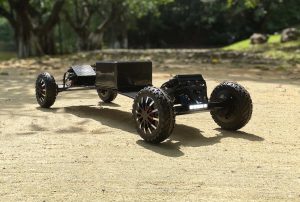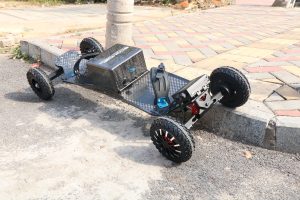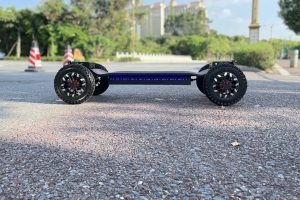Skateboarding is a sport that can be enjoyed on any surface, but rough roads can present unique challenges. If you’re new to skating or looking to improve your skills on uneven or bumpy surfaces, this article is for you. We’ll provide tips and techniques on how to skate on rough terrain safely and confidently.

Skateboards vs. Rough Terrain
Rough terrain presents many challenges for skateboarders. The ground is mostly level and smooth when skating on streets, sidewalks, and parking lots. However, when transitioning to off-road skating on dirt, gravel, or grass, you encounter many bumps, cracks, and small ledges that make control difficult. Uneven ground easily throws off your balance and causes the board to shift or turn unexpectedly. The constant adjustments required to navigate rough terrain can tire your legs faster and negatively impact your technique. High obstacles like curbs, logs, and rocks also pose potential hazards not present on smoother surfaces. Proper stance, wheel selection, and going at a slow pace initially can help you improve your rough terrain skateboarding skills.
Adjust your Stance
Adjusting your skateboard stance is one of the most effective ways to improve your skating performance on rough terrain. Adopting a wider stance that evenly distributes your weight can provide better stability over bumps and cracks. You may also need to lower your stance by bending more at the knees to get closer to the board’s center of gravity. This low and wide stance allows you to absorb impacts better and shift your weight quickly in response to terrain changes. In addition, you may need to loosen the bolt on your skateboard trucks to give the wheels a wider angle of turning. The increased maneuverability helps navigate high obstacles while keeping the board balanced during turns and carves. Experimenting with your stance width, height, and truck tightness can make a huge difference when skating off-road.

Softer Wheels
Another effective way to navigate rough terrain on a skateboard is to utilize softer wheels that are specially designed for off-road skating. Wider, gripper wheels made of soft rubber mixtures can conform better to uneven ground, providing increased traction. The added tackiness of grippy rubber compound wheels helps them bite into dirt, grass, and gravel for improved control and stability. Larger wheel diameters, typically ranging from 70mm to 100mm, work best for skating on bumpy surfaces. The extra size allows the wheels to roll over or absorb obstacles more easily. Softer wheel compositions and larger diameters are both characteristics to look for when purchasing off-road skateboard wheels. Switching to proper terrain wheels can transform your rough ground skating experience, enabling you to take on terrain that seemed impossible with standard street skateboard wheels.
Go Slow at First
When first transitioning from smooth surfaces to skating on rough terrain, it is important to start slow and build up your skills gradually. Going too fast right away greatly increases the likelihood of losing control and falling off your board. Starting at a slow, comfortable cruising speed allows you to find your balance and adjust your stance to suit the new conditions. As your confidence grows with practice at slower speeds, you can slowly start to pick up the pace. But initially, taking things easy is key to building a solid foundation of skill and comfort riding on bumpy ground. With a slow, steady approach, you can focus on perfecting the movements, balance, and techniques necessary to navigate uneven terrain. So when you first step foot on dirt, grass, or gravel with your skateboard, remember to start slow. Build up your speed and agility once basic balancing and controlling skills have been established at a slower pace.

Try Different Techniques
Once you have the proper setup and have practiced the basics at slow speeds, the next step is to experiment with different techniques tailored for rough terrain skating.
- Crossing obstacles: Learn how to ollie over bumps, cracks, and small logs. Practice hopping the board to keep the momentum going over rough patches.
- Carving: Exaggerated turns and wide arcing carves can help maintain control on uneven ground. Carving distributes your weight better and allows the wheels to roll over bumps at an angle.
- Pumping: Pumping up and down larger bumps and hills can maintain or generate speed. By compressing and re-extending your legs with the terrain, you can ride “with” the bumps instead of trying to resist them.
Different skateboarding tricks also translate well to rough terrains, such as manuals, balance tricks, and slowing slide of the wheels to scrub speed.
Start by practicing basic maneuvers one at a time to build rough terrain riding skills. Then experiment with combining techniques in different ways to find what works best on gravel, grass, dirt, and other surfaces. The more tricks you have in your bag, the more adaptable your skating can be to any terrain you encounter.
Read More
- How To Choose The Right Remote Control For Electric Skateboard – Ecomobl
- Electric Longboard Skateboards Rain – Ecomobl
- Off Road Electric Skateboards Safety – Ecomobl
- The Best Electric Skateboard With An Affordable Price – Ecomobl
- Off Road Electric Skateboarding Tips – Ecomobl




